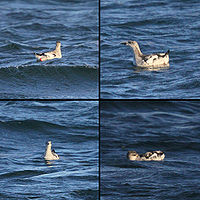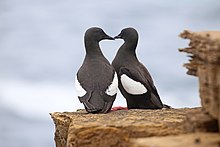Black guillemot
| Black guillemot | |
|---|---|

| |
| Black guillemot resting on a cliff in Reykjanes, Iceland | |
| Scientific classification | |
| Domain: | Eukaryota |
| Kingdom: | Animalia |
| Phylum: | Chordata |
| Class: | Aves |
| Order: | Charadriiformes |
| Family: | Alcidae |
| Genus: | Cepphus |
| Species: | C. grylle
|
| Binomial name | |
| Cepphus grylle | |

| |
| Synonyms | |
| |
The black guillemot or tystie (Cepphus grylle) is a medium-sized seabird of the
Both sexes have very similar appearances with black plumage and a large white patch on the upper side of their wings in summer. The bill is also black, being rather long and slender, while the feet are coral-red. In winter adult underparts are white and the upperparts are a pale grey with the back and shoulders exhibiting barred light grey and white patterning.
The birds breed in solitary pairs or small groups during their breeding season starting in late February and early May. Pairs nest above the high tide mark, usually in cliff crevices or gaps in boulders.[2] Many pairs lack true nests and lay directly on the ground. Breeding pairs will typically lay 2-egg clutches and raise 2 chicks to fledging. Eggs are a dull white to pale green in color, boldly marked with dark spots and blotches.[2] Incubation by both parents typically lasts 28 to 32 days. Once hatched, chicks are covered with black down and receive care from the parents until they fledge aged 30 – 40 days, unaccompanied by their parents. Once fledged, chicks are totally independent and by age three or four years they will begin to re-join their natal colony.
The genus name Cepphus is from Ancient Greek kepphos, a pale waterbird mentioned by Greek authors including Aristotle. The species name grylle was the local dialect name for this bird in Gotland at the time of Linnaeus's visit there in 1741.[3] The English word "guillemot" is from French guillemot probably derived from Guillaume, "William".[4]
Description
The black guillemot is a medium-sized bird with adults normally 30 to 32 centimetres (12 to 12+1⁄2 inches) in length and with wingspans of 52 to 58 cm (20+1⁄2 to 23 in). The bodyweight can range from 300 to 460 grams (10+1⁄2 to 16 ounces). Adults have both summer and winter plumage and there is no sexual difference in this that can be identified in the field. The English common name “Black Guillemot” references their strikingly black breeding summer plumage which is totally black except for a large white patch on the upper side of their wings. During the summer plumage, their legs, feet and inside of the mouth are all a bright coral-red, and their beak is a black. Adults lose their summer plumage in an early fall moult where their upper plumage become barred with light grey and white, their head is a pale grey, their underparts white, and legs and feet a pale red. They retain their white wing patch, black beak and red inside their mouth. The call in the breeding season is a high whistle. The red
Juveniles and immatures can easily be identified by the spotting of the white wing patch with grey or brown feathers and is easy to see even at far distances in the field.


Taxonomy and evolution
There are five listed subspecies of the black guillemot:[5]
- Cepphus grylle mandtii – ( and northern Alaska
- Cepphus grylle arcticus – (Brehm, 1824): northeast United States, southeast Canada and south Greenland to Ireland and Britain, southern Scandinavia and the White Sea
- Cepphus grylle islandicus – (Hørring, 1937): Iceland
- Cepphus grylle faroeensis – (Brehm, 1831): Faroe Islands
- Cepphus grylle grylle – (Linnaeus, 1758): Baltic Sea
Distribution and habitat

The black guillemot is a circumpolar species distributed in the boreal, low arctic and high arctic regions of the north Atlantic and arctic oceans and breeding between 43° and 82°N. The 5 listed subspecies inhabit different parts of this range. In North America, they can be found as far south as the Gulf of Maine and New England and across parts of the northern coast of North America as far as Alaska, where they are replaced by the pigeon guillemot in the North Pacific. In Europe and Asia, they are found from the British Isles and Northward across the northern coast of Asia. They are one of the few birds to breed on Surtsey, Iceland, a new volcanic island. It is a fairly common breeding bird in western and northern Scotland and Ireland. In Great Britain, they only breed at St. Bees Head in Cumbria, the Isle of Man and on east Anglesey in north Wales. Approximately 40% of the population breeds in the high arctic where the largest colonies are found, 30% in the low arctic, and 30% in boreal waters. In the winter, some of the birds in the high arctic waters are forced south by the winter ice making them seasonal migrants, but in more temperate zones the species is essentially resident.
Typically restricted to rocky shores, black guillemots utilize the cliffs, crevices and boulders for their nests, hunting the inshore waters for benthic prey. Compared to other auks, they forage fairly close to the colony, in the breeding season mostly in inshore waters more than 50m in depth, farther afield in the winter months.
Behaviour
One of the early
Black guillemots are coastal foragers with diets typically associated with benthic and kelp-forest prey. They dive between 15-20m to catch their prey, but can dive to a depth of at least 43m.[8] They use their wings to propel themselves forward and their feet to steer. [2] Small prey are swallowed underwater whole. Guillemots bring larger prey to the surface to soften in their bill before swallowing whole. [2] Guillemots are single-prey loaders, meaning they bring single prey items back to their chicks during the chick-rearing period. This limits the spatial range that parents can forage for food, as chicks must receive a high number of energy-rich prey items throughout each day. [8] Black guillemot diets include sculpins, butterfish, rock gunnel, northern sandlance, herring, jellyfish, mollusks, and other small crustaceans. [2][8]
Threats
A number of threats face Black guillemots. Black guillemots have been shown to be vulnerable to several species of predators including American Mink, Great Skua, gulls, and Otter Lutra Lutra, as well as introduced species like the Brown Rat and feral cats. [9][10] One large colony on an island in the Baltic Sea (approximately 2600 individuals) was wiped out by American Mink in the early 2000s. [10] Because Black guillemots forage close to shore, they tend to be exposed to more pollution than further oceangoing seabirds.[2]Additional sources of pressure include fisheries bycatch, habitat destruction, and climate change. [10]
References
- . Retrieved 11 November 2021.
- ^ a b c d e f "Black Guillemot Life History, All About Birds, Cornell Lab of Ornithology". www.allaboutbirds.org. Retrieved 2024-04-21.
- ]
- ^ "Guillemot". Oxford English Dictionary (Online ed.). Oxford University Press. (Subscription or participating institution membership required.) [verification needed]
- ^ Gill, Frank; Donsker, David, eds. (2019). "Noddies, gulls, terns, auks". World Bird List Version 9.2. International Ornithologists' Union. Retrieved 24 June 2019.
- ^ Selous (1905).
- ^ Selous (1905), p. 68f.
- ^ ISSN 1432-1793.
- .
- ^ ISSN 0006-3657.
Literature
- Leonard, K. 2008. Black Guillemots on the Copeland Islands in 2008. Annual Report for 2008. Copeland Bird Observatory. p. 50.
- Selous, Edmund (1905). – via Wikisource.
External links
 Media related to Cepphus grylle at Wikimedia Commons
Media related to Cepphus grylle at Wikimedia Commons Data related to Cepphus grylle at Wikispecies
Data related to Cepphus grylle at Wikispecies

